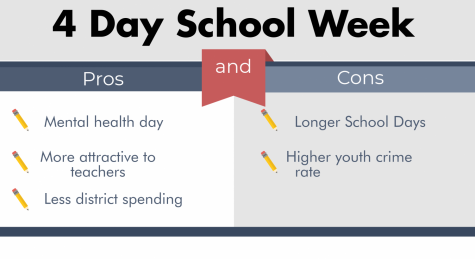Four day school week: Is it for the students?
November 1, 2018

The merits of a 4-day school week have yet to be fully discussed and studied completely, but so far, the pro’s seem to outweigh the con’s. A study done by the Journal of Education and Training Studies has repeatedly shown that with the four-day system, costs have been cut anywhere from .4% to 2.5%.
According to the OPS 2016-2017 budget of over 582 million dollars, this could amount to up to 14.5 million dollars back. In a district that is being forced to scale back on busing due to costs, this could be heavily needed. Along with the cost cuts there are studies that have shown that there is a boost in student and staff morale.
The research tends to lean towards both sides depending on who you ask. While the Journal of Education and Training Studies claims that while staff morale and academic quality was raised, there are some drawbacks to the idea.
The idea of a 4-day week would be more beneficial to students and teachers alike. Being able to take a mental health day would be favorable to many of the overstressed and overworked students that face todays struggles in school. There are very few parts of school that are easy.
Every morning most students wake up between 4 and 6 o’clock. They are tired, most of them have not eaten breakfast in a long time, and they’re ready to be done with school. At the end of the day, if there is anything these students want it is to just have a little more time to finish the large quantities of homework they’re receiving.
The amount of work is even worse for the honors and AP students that are getting an average of 6 hours of sleep per night. In my experience this is longer than usual. No amount of technology, schedule changes, or coffee will ever replace the extra day off that these students need.
Some argue that youth crime is a possible outcome of this schedule change. The Economics of Education Review suggests that while the students with 4-day schedules may have gone the same amount of time per week as a 5-day school, there was at most a 20% increase in crime in the most extreme cases.
With this, OPS would also have to find a meal since they provide breakfast and lunch. Without them, many kids would not have the access to the meals provided. Many kids rely on the meal that OPS provide, some homes may not have the money or the ability to feed everyone.
In addition to this, the school day would have to be extended to fit the same number of hours required by the state to be in school, but with one less day in the week. This could mean a school day up to 2 hours longer to equate to the 5th day. This could end up harder on the student but it could be balanced out with the extra day off. They technically still save money since they’d provide one less meal and one less day of busing.
Student perception would be different than you think. When a store charges $1.99 for something. They do it because you see the big picture of it’s still technically one dollar, just with a little change.
Students are likely to be okay with the idea of being in school longer simply for the fact that they’re more likely to look at that bigger picture of less days to be in school, not the extra change of a few extra hours here and there.
Instituting a 4-day week at the potential cost of more school time year-round would be worth it. In the end the benefits outweigh the costs associated with such a big change in a student’s educational development.


